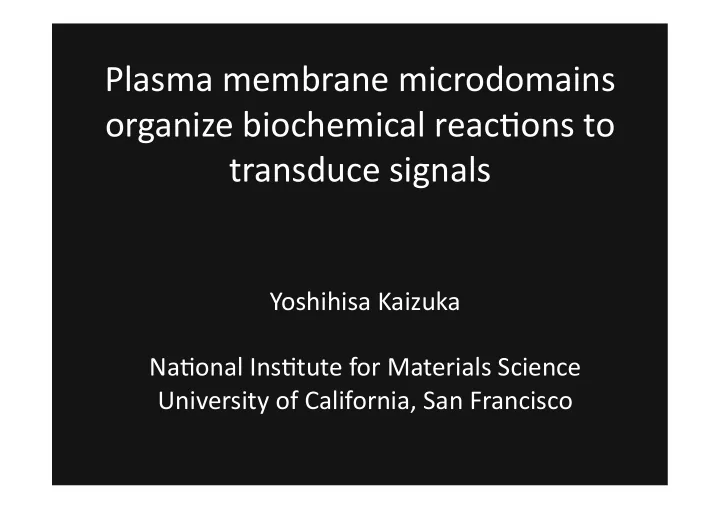

Plasma membrane microdomains organize biochemical reac2ons to transduce signals Yoshihisa Kaizuka Na2onal Ins2tute for Materials Science University of California, San Francisco
T cell membrane microdomains: dynamic and fluid structures Mobility of proteins: FRAP Single molecule tracking of fluorescent proteins Douglass and Vale
Modula2on of molecular conforma2ons‐ func2ons by lateral organiza2ons T cell Lck Receptor enriched membrane microdomain
Signal transduc2on in T cell ac2va2on T Cell Nucleus Actin ER NFAT Rac talin Ca NFkB LFA ERK STIM Orai Cdc42 Jun etc. IKK WASP IP3R JNK WAVE MEK PI3K IP3 CD28 PKC PTEN ZAP70 DAG PIP2 Nck CD8 SLp76 PLCg1 CD4 Itk Grb2 RasGRP CD2 CD148 Fyn Sos Ras Lck CD45 LAT TCR Antigen presenting cell Antigen
Cri2cal kinase Lck is ac2vated on plasma membrane T Cell How is Lck ac2vated? Lck (src kinase) – CD45 (phosphatase) – Receptor Lck CD45 TCR
How is Lck ac2vated in T cell? How is Lck opened in T cell? (release of autoinhibitory interac2ons) Catalytic domain Loop SH2 SH3 Phospho- membrane tyrosine Lck Inactive Lck Active
Model: Locally Concentrated Receptors Ac2vate Lck by Releasing Autoinhibitory Interac2ons T cell Lck Receptor enriched membrane microdomain
Imaging T Cell membrane microdomains Side View Ligand for T cell Glass substrate - Mimic cell-cell interaction - Biochemical control - Surface-based imaging (TIRF, confocal)
Microdomain forma2on in ac2vated T Cell membranes 5µm - Functional assays show T cell is activated upon microdomain formations, suggesting Lck activation. - How does Lck activation occur?
Lck is ac2vated in microdomains Wildtype Lck microdomains active inactive GFP GFP Open form mutant Lck microdomains (Y505F) GFP 2µm
Mechanisms for Ac2ve Lck Localiza2on (1) Cytoplasmic domain deletion Open Lck enrichment in microdomain microdomains Receptor cytoplasmic domain is required for Lck activation
Dynamic and transient ac2va2on of Lck in microdomains facilitates T cell ac2va2on TCR Lck
Mechanisms for Ac2ve Lck Localiza2on (2) Lck microdomains CD45 Phosphatase CD45 is excluded from microdomain CD45 as a negative regulator
Localized Ac2ve Lck Facilitates Downstream Signaling microdomains merge
Acknowledgement NIMS UCSF (Na2onal Ins2tute for Ron Vale Materials Science, Tsukuba) Adam Douglass Ling Zhang Ivan Yudushkin Gabi Furlan John James Huang Li Nico Sturrman Patrick Hofer Art Weiss (UCSF) Nobutaka Hanagata, Takashi Jay Groves (UCB) minowa, Tomohiko Yamazaki Mike Dus2n (NYU)
Recommend
More recommend